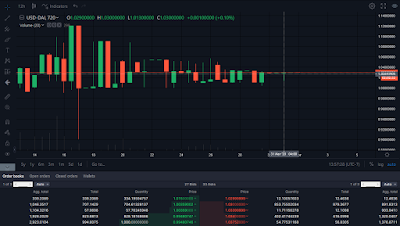To my surprise, Wikipedia doesn't have an article on the DAI cryptocurrency itself, but just on the organization that oversees it (link). DAI is an Ethereum token that can be stored in a cold storage wallet (link) or holding it via an exchange (link). Moreover, it has a "decentralized finance" application using the Ethereum blockchain -- a way to borrow "money". This post is a brief summary of information I collected on MakerDAO DAI from the point of view of trading it.
Why trade DAI?
Unlike BTC or ETH, there's no question on what a stablecoin's true value should be. It should be 1:1 against whatever asset they are supposed to be pegged against. But despite the name, stablecoin prices do vary. For example, the USD-DAI exchange rate is 1.030 on Bittrex as of March 30 2020.
Trading BTC or ETH might be preferred if you want large potential upside and can handle the downside. USD-BTC dropped more than $3000 in value over 1 day on March 12. Stablecoins is something to keep in mind if you prefer less risk and is ok to settle for much lower return.
How the DAI system that drives prices works?
To borrow money, you would do so using the DAI system with a wallet (like Metamask). An example:
- You have 10 ETH worth $1000 and want to borrow money
- You use your 10 ETH ($1000 worth ) as collateral and borrow 700 DAI ($700 worth) at 10% interest, using the DAI system.
- You use your 700 DAI to do things (buy things, invest in things, speculate, etc.)
- When you want your 10 ETH back, you can go back to the DAI system and pay back 700 DAI + interest. So after 1 period, you need 770 DAI to get back your 10 ETH.
But why would anyone borrow DAI with an ETH collateral? A couple of reasons:
- If DAI is treated like money, then this is no different from borrowing money using a collateral -- like using your house to get an equity loan from the bank. Maybe you have a business and need money. You can use your ETH to borrow DAI, (and maybe even convert DAI to USD and withdraw it into the real world), and invest it into something that will give you more money in the future. Then, with more money, you can pay back the loan and interest to get back your ETH collateral.
- What's the different between using ETH for money vs. the DAI system for money? Imagine you instead sell your 10 ETH ($1000 worth) for USD and use it for investing. If prices of ETH doubles, you've "missed out" in a similar way as the bitcoin pizza folk (link). With DAI, you can get back your 10 ETH (now $2000 worth) by getting 700 DAI plus interest. If the DAI system work, DAI should still be worth around $700 USD.
How to hopefully profit from DAI?
So to potentially profit from DAI price fluctuations, you can arbitrage using the lending/borrowing system above. Alternatively, if you have enough confidence in the DAI system to keep the DAI stable at $1, you can also skip the above and trade DAI on an exchange like Bittrex -- buy when prices is below $1, and sell when it is above $1, while accounting for transaction fees. There are risks invovlves with all stablecoins. While the decentralization of the DAI eliminates some risks that central coins like USDT has, this decentalization also creates other risks. DAI being essentially an ETH application means that it can be hacked. From the DAO Wikipedia page:
In June 2016, users exploited a vulnerability in The DAO code to enable them to siphon off one-third of The DAO's funds to a subsidiary account. On 20 July 2016 01:20:40 PM +UTC at Block 1920000, the Ethereum community decided to hard-fork the Ethereum blockchain to restore virtually all funds to the original contract.[12] This was controversial, and led to a fork in Ethereum, where the original unforked blockchain was maintained as Ethereum Classic, thus breaking Ethereum into two separate active blockchains, each with its own cryptocurrency. (link)
Also, the actions of some folks known as the MKR holders have the potential to either stabilize or destabilize the value and viability of DAI short term during financial shocks and longer term due to inability to adapt to market changes (link).
Conclusion
You can potentially profit from DAI by doing the DAI borrowing arbitrage, or you can just take that coin's ability to be stable as given and trade aroudn the stable vaule. The downside risk of trading stablecoins in general is that something can go wrong with the stablecoin. With USDT, you worry about accounting irregularities of the organization that creates the USDT. With DAI, the decentralization eliminates the accounting irregulaty risk, but it creates risks from hacking.
If you don't have a crypto exchange account and is interested in starting, consider supporting this blog by using my Bittrex referral (link). If you have other questions, please post to the comments and I might reply or use it as the topic of a new post.
Reference:
https://medium.com/mycrypto/what-is-dai-and-how-does-it-work-742d09ba25d6
https://www.youtube.com/watch?v=J9q8hkyy8oM
